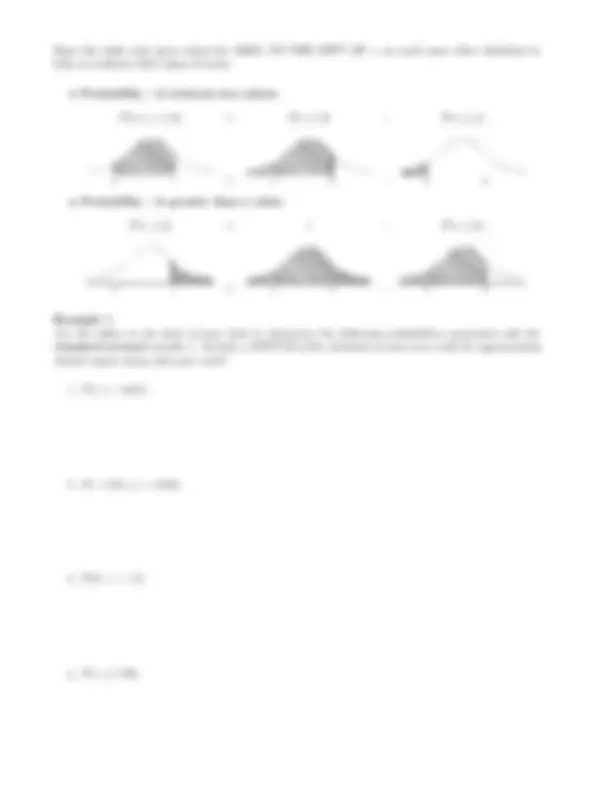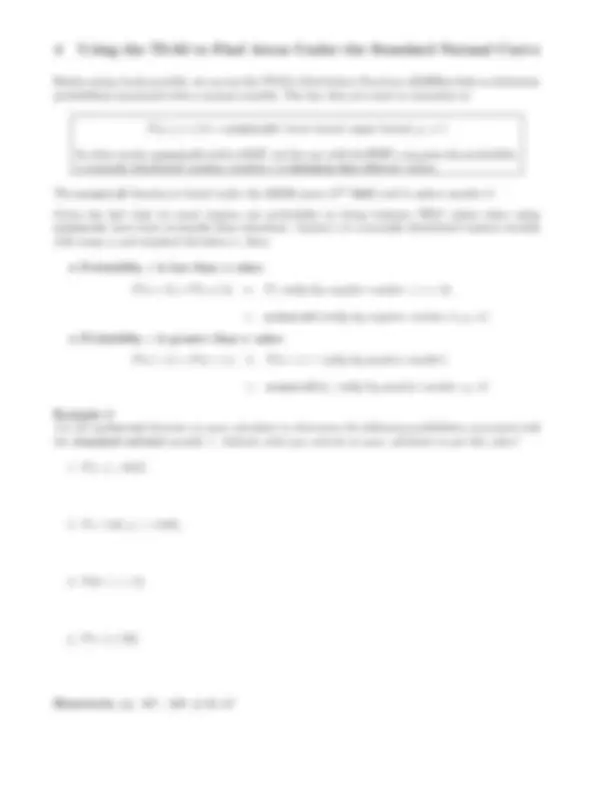




Study with the several resources on Docsity

Earn points by helping other students or get them with a premium plan


Prepare for your exams
Study with the several resources on Docsity

Earn points to download
Earn points by helping other students or get them with a premium plan
Community
Ask the community for help and clear up your study doubts
Discover the best universities in your country according to Docsity users
Free resources
Download our free guides on studying techniques, anxiety management strategies, and thesis advice from Docsity tutors
The normal distribution and its relation to the standard normal distribution. It explains how to find probabilities associated with a standard normal variable using a look-up table and a ti-83 calculator. Examples and formulas.
Typology: Assignments
1 / 4

This page cannot be seen from the preview
Don't miss anything!



MATH 170 - Applied Statistics Section 7.6 Normal Distribution – Part I
We’ve dealt with normal curves before ... recall what they look like.
Definition 1 (Normally Distributed Random Variable) A continuous random variable x is said to have a normal distribution if its density curve is a normal curve. Features of the density curve for a normally distributed random variable are:
An infinite number of combinations of μ and σ exist, and we concentrate on a very simple μ, σ pairing.
Definition 2 (Standard Normal Distribution) A continuous random variable, z, is said to have a standard normal distribution if it has a normal distribution with mean μ = 0 and standard deviation σ = 1. The corresponding density curve is referred to as the standard normal or z-curve.
The z-Curve
We’ve mentioned before that the area under a normal curve is not one we can calculate using simple geometry formulas. So we’ll use two different methods for determining the area under a portion of the standard normal curve: first, using a look-up-table, and second, using the TI-83.
Let c denote a number between -3.89 and 3.89 (as high and low as the table goes) that has two digits to the right of the decimal point. For such a c, the table in the book’s back page gives the area to the LEFT of c under the normal curve, i.e.
area under the curve and to the LEFT of c m cumulative area to the left of c m P (z < c) = P (z ≤ c)
P (z < c) = P (z ≤ c)
To read the probability from the table, locate:
The desired probability (area) is the number at the intersection of this row and column. The illustration below shows how to look up P (z ≤ 2 .37) from the table:
P (z ≤ 2 .37) = 0. 9911
Rather using a look-up table, we can use the TI-83’s Distribution Functions (DISTR)to help us determine probabilities associated with a normal variable. The key idea you want to remember is:
P (a ≤ x ≤ b) = normalcdf( lower bound, upper bound, μ, σ )
In other words, normalcdf (with a CDF, not the one with the PDF) computes the probability a normally distributed random variable x is between two different values.
The normalcdf function is found under the DISTR menu (2nd^ VARS) and is option number 2.
Given the fact that we must express our probability as being between TWO values when using normalcdf, here’s how we handle other situations. Assume x is a normally distributed random variable with mean μ and standard deviation σ, then:
P (x < b) = P (x ≤ b) ≈ P ( really big negative number < x < b)
= normalcdf(really big negative number, b, μ, σ)
= normalcdf(a, really big positive number, μ, σ)
Example 2 Use the normalcdf function on your calculator to determine the following probabilities associated with the standard normal variable z. Indicate what you entered on your calculator to get this value!
Homework: pp. 407 - 409: # 65, 67